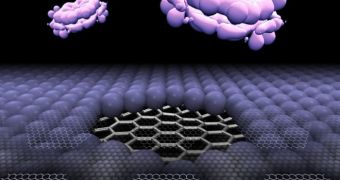Everyone knows that graphene is the one-atom-thick carbon compound that holds the promise to innovate the world of the electronics industry. But very few people know that the insulating equivalent of this material, called graphane, is also right up there in terms of preferences, at least from the scientific community. Researchers around the world are investigating its properties in order to construct new and advanced chips and integrated circuits, and scientists at the Rice University are also a part of this effort.
Recently, they managed a breakthrough in the field, when they learned how to strategically-extract hydrogen atoms from a two-dimensional sheet of graphane, in order to obtain naturally-occurring graphene patches.
What's even more outstanding is the fact that these graphene patches look and act like quantum dots, the basic hypothesized units for tomorrow's quantum computers. These machines will feature massive computational power, far exceeding today's most advanced supercomputers. However, creating them has proven to be extremely difficult, especially due to the delicate nature of the quantum phenomena they must rely on. The new investigation could give physicists working on these issues a new way of tackling the complex problems ahead.
The work could also have extensive applications in the field of advanced optics. The research team says that their new method extracts hydrogen from a sub-lattice in graphane. The exposed graphene patch always has a hexagonal structure, the scientists add, and a crisp boundary exists between them and the surrounding graphane. The study was conducted in the lab of Boris Yakobson, an internationally-renowned professor of mechanical engineering, materials science and chemistry at Rice. Additional theoretical work was carried out by postdoctoral researchers Abhishek Singh and Evgeni Penev, who are also based at the university.
“We arrived at these ideas from an entirely different study of energy storage in a form of hydrogen adsorption on graphene. Abhishek and Evgeni realized that this phase transformation (from graphene to graphane), accompanied by the change from metal to insulator, offers a novel palette for nanoengineering,” Yakobson explains. "We think the major conclusions in the paper are enough to excite experimentalists. Some are already working in the directions we explored,” says Singh. “Their work is actually supporting what we're suggesting, that you can do this patterning in a controlled way.” Penev adds.

 14 DAY TRIAL //
14 DAY TRIAL //